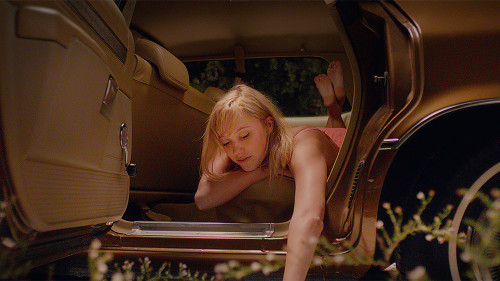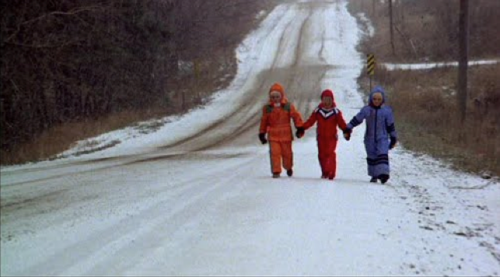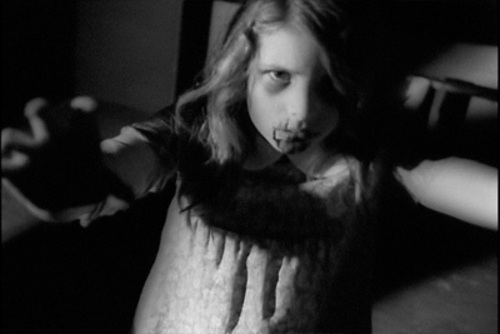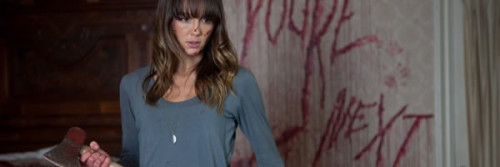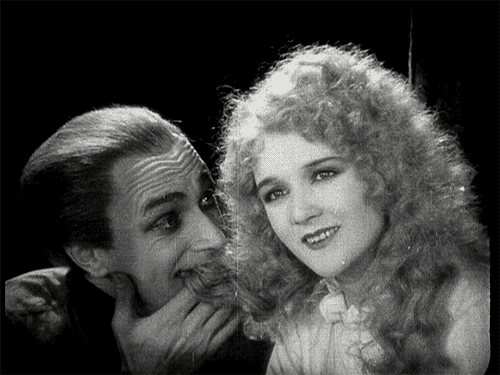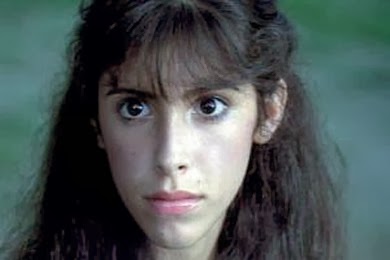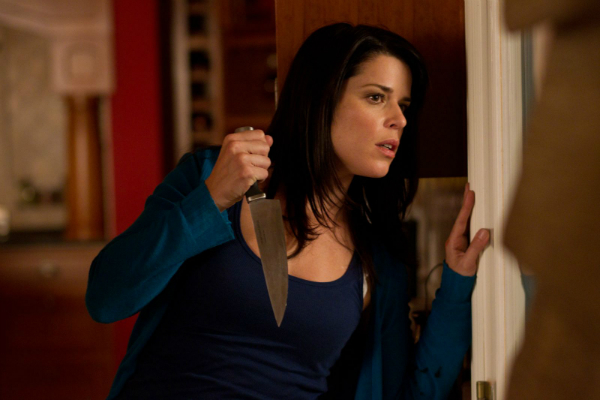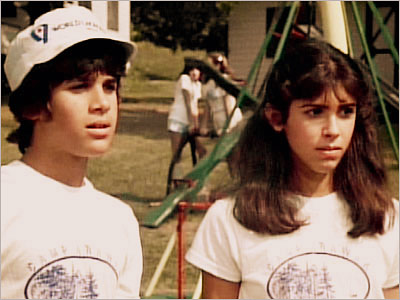This is a guest post by Andrea Betanzos.
Once upon a time, I took a course in film school about horror films and learned that Leatherface’s chainsaw, Jason’s machete, and every other male killer’s choice of weapon were simply metaphors for their dicks.
When it slowly dawned on all of us (my classmates and I) that this was the central analysis our professor was looking for us to make, I’m sure our assignments must have been pretty interesting to read.
Horror and sci-fi seem to be the few genres where the actions of women stem from their own wills. In order to be the “final girl,” a woman must want to survive, must find it in herself to reject the role of caretaker, and find a way to fight. To be lethal, a woman must chase a singular idea, must view the road to her objectives as necessary and in no way compromise what’s hers.
In other words, there are less garage tools involved.
Before “Hit Girl” in 2010’s Kick-Ass and “Esther” in 2009’s Orphan, there was 8-year-old Rhoda Penmark, (the amazing Patty McCormack), the central character in Marvin Leroy’s classic The Bad Seed.
Let me clarify, we’re talking about the classier 1954 version of the film.
Not the 1985 one. Or the Lifetime one.
The golden child
Adapted from the novel written by William March, The Bad Seed was made during the imposed Hays Code in Hollywood. Despite the limitations the Code placed on the story and what could actually be shown onscreen, the strength still lies in the ruthlessness of Rhoda’s sociopathic evil.
The only child of Christine (portrayed by Nancy Kelly) and Kenneth (William Hopper), Rhoda lives the idyllic childhood. Christine is a homemaker and the daughter of an esteemed crime writer, Richard Bravo. Col. Kenneth Penmark is an absent father who dotes on Rhoda and is on military leave for most of the film. The family lives in a picturesque suburb, renting an apartment from nosy landlord, Monica and an even nosier caretaker, Leroy.
With blonde pigtails, a perfect curtsy and charming smile, Rhoda is a pristine and well-behaved child. Her bedroom is always tidy, her chores are always done, and her speech is impeccable. However, beneath Rhoda’s immaculate exterior lies a boiling rage.
When Claude Daigle (Rhoda’s fellow classmate) beats her in a penmanship contest, and soon thereafter dies under suspicious circumstances, Rhoda’s true character is revealed. Her apathy towards his death is potent. The conviction with which she believes the award belongs to her is unsettling, considering that most children can barely decide what they want for Christmas. You rarely see this kind of devotion in adults, but at 8 years old, Rhoda not only possesses it, she owns it. Christine attempts to defend Rhoda unto everyone, as any mother would. Yet we watch her resolve crumble slowly, as she comes to the horrifying realization that her daughter is indeed, a murderer.
Almost every horror film does a fantastic job in blaming mom for birthing such fine human beings, (1980’s Friday the 13th, 1968’s Rosemary’s Baby), and this film is no different. Evil originates from a lineage of women. There is a legacy of murderesses, beginning with Bessie Denker, a notorious serial killer and Christine’s mother. Christine herself, who goes to great lengths to make Rhoda disappear. And last but not least, sweet Rhoda, who takes the reign and really puts everyone to shame with her prolific slew of murders.
Yes, the film is campy. Yes, it seems like Christine is always a few seconds from crying in every single scene. Yes, there’s so much overacting that it makes you eye-roll at the most inappropriate moments. But the relationship between Christine and Rhoda is fascinating, akin to Carrie and Margaret White in 1976’s Carrie. The constant push and pull. The way in which mother and daughter are both destructive and protective towards one another. The dualities of violence found within each Christine and Rhoda, how they intersect and compliment one another, give the film its complexity and nuance.
Rhoda and Christine illustrate two types of violence: one which is carried out maliciously, meant to harm those around her in the pursuit of her desires. The second is violence toward oneself, meant to protect the world, and transform her into martyr to erase a lineage that is destructive. It could very well be said that Christine represents our “final girl,” who must protect herself to survive. Rhoda is the monster, the Jason and Leatherface without the garage tools.
For this film, these two types of violence are incapable of existing without the other. They feed and sustain one another. Rhoda is birthed by said lineage of evil and learns how to take control of her abilities to get what she wants. She is for better or worse, driven and unapologetic in fighting for what’s hers. In a terrible way (i.e. not recommended to anyone!), Rhoda finds autonomy through deciding what role each person plays in her life. If they’ve wronged her, they have no place in her life. Throughout the course of the film, she only learns how to be more decisive in what she wants in needs. Rhoda learns how to manipulate situations in her favor. Let’s be clear though: if we weren’t talking about murder, this would be otherwise be admirable!
A feminist killer?
Christine’s arc is much more different, as she begins the story as fiercely protective of Rhoda. She is proud of her daughter’s perfection and proud to be her mother. Even when the first inklings of Rhoda’s behavior come to light, her maternal instinct to overrules reason. Regardless of how dangerous Rhoda is, Christine is still charmed by her daughter and in total disbelief that she could be capable of being evil. Yet when Christine actually witnesses one of Rhoda’s murders, she uses that same fervor to find strength and protect others from Rhoda. Yes, “final girls” must often reject the role of caretaker in order to protect themselves. In this case, it’s especially pronounced given that Christine must reject the role of mother. However, the real difference in this feminized violence is how Christine handles it. Rather than blame outward, she holds herself responsible for what she has created and tries to kill herself, but not without trying to kill Rhoda first.
Not Flintstones vitamins
Rhoda’s conviction has to lead her toward destroying others and Christine’s toward destroying herself.
Although both depictions are incredibly diverse and rarely juxtaposed, part of the problem is that there is no “in between”. The film almost hints that women are too emotional to make a careful decision and when they do; it can become too calculating and may deviate to cruelty. The extremes of each type of violence are just that, extremes. Yes, its unfortunate that each woman in The Bad Seed finds power and control through some pretty evil deeds. In no way does this piece condone violence or 8-year-old serial killers. We all know that’s wrong and our mothers taught us better than that. But really, what’s the harm in a female character with autonomy and direction?
Sorry not sorry
See also at Bitch Flicks: The Terror of Little Girls: Social Anxiety About Women in Horrifying Girlhood
Andrea Betanzos likes dessert before dinner, strong coffee, feminism, and very good films.





